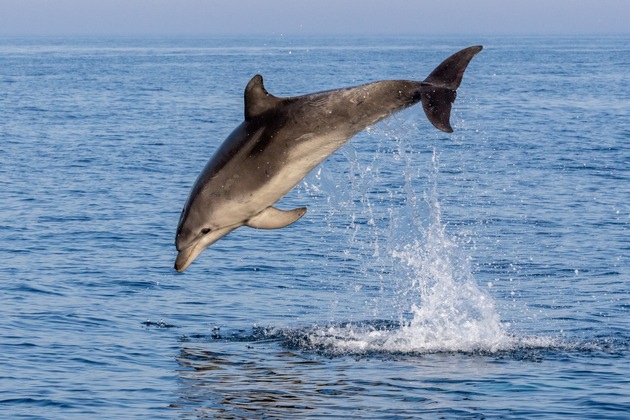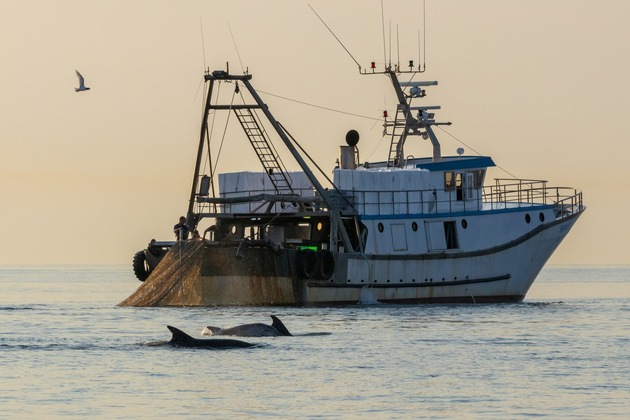New study: Urgent science-based conservation action needed for Adriatic whales and dolphins
Un document
In a new scientific article published in the journal Acta Adriatica scientists review conservation status of whales and dolphins in the Adriatic Sea. The article documents the low occurrence of some species, discusses the main threats caused by human activities, and recommends specific conservation action. The international marine conservation organisation OceanCare sees this publication as a call to scale up restoration efforts and prevent further biodiversity loss.
PRESS RELEASE – 01/02/2024
New study: Urgent science-based conservation action needed for Adriatic whales and dolphins
Takeaway points:
- The Adriatic Sea, home to several cetacean species such as the striped dolphin and the bottlenose dolphin, is one of the world's most intensively trawled and overfished areas.
- Thousands of dolphins were deliberately killed between the 19th and the mid 20th century.
- One dolphin species (the common dolphin) has declined dramatically, and it has not recovered.
- Human impact in this part of the Mediterranean is extremely high, according to a new scientific study on the past and present conservation status of whales and dolphins in the Adriatic Sea, published in the journal Acta Adriatica.
- The international marine conservation organisation OceanCare supports the authors' call for timely science-based conservation action to ensure the survival of all Adriatic cetaceans, and bring them back to their original vibrancy.
In a new scientific article published in the journal Acta Adriatica scientists review the past and present conservation status of whales and dolphins in the Adriatic Sea. The article documents the low occurrence of some species, discusses the main threats caused by human activities, and recommends specific conservation action. The international marine conservation organisation OceanCare sees this publication as a call to scale up restoration efforts and prevent further biodiversity loss.
The semi-enclosed Adriatic Sea has long been one of the Mediterranean areas most exposed to destructive human impacts, resulting in biodiversity decline and poor ecosystem health. Can anyone expect to find much diversity of cetaceans within a sea so intensively overexploited? And how many whale and dolphin species can possibly live there, while managing to reproduce and find sufficient food?
A new article offers exhaustive answers to these questions. The lead author, Giovanni Bearzi, is a pioneer of cetacean research who started studying Adriatic dolphins in the late 1980s. He explains that the diversity of cetaceans in this area is relatively low: “Here, dolphins and whales have been facing threats that include the effects of habitat degradation, incidental mortality and prey depletion caused by fisheries, anthropogenic noise (such as that caused by seismic surveys for hydrocarbon prospection), chemical contamination and – indeed – climate change.” Bearzi believes that fisheries, in particular, have been the main driver of ecosystem degradation. This sea has been fished intensively since historical times, and today the Adriatic Sea is one of the most intensively trawled areas anywhere. It also has one of the worst seabed conditions, globally.
As the publication points out, some cetacean species don't fare well at all. For instance, common dolphins Delphinus delphis used to be plentiful in the Adriatic, including in its shallow northern waters. No longer so. Bearzi reports: “In the past, dolphins were regarded as pests and the practice of killing them was common and widespread, largely as an attempt to reduce conflict with fisheries. In the Adriatic Sea, dolphin extermination campaigns were promoted by the authorities responsible for fisheries management, and these killings were carried out for more than a century, until as recently as the 1960s.” Strikingly, thousands of dolphins were deliberately killed. By the 1990s, common dolphins had virtually disappeared from this region. Recent scientific evidence suggests that common dolphin numbers have remained very low. The species' recovery is thought to have been compromised by prey depletion caused by overfishing, and by habitat degradation.
Today, the bottlenose dolphin Tursiops truncatus is the only species observed regularly in the northern Adriatic Sea. A greater variety of species can be found as one moves southward, towards the deeper waters of the central sector and the much deeper southern sector. The most abundant species is the striped dolphin Stenella coeruleoalba, but its range tends to be confined to the deep waters of the southern Adriatic. Risso's dolphins Grampus griseus and Cuvier's beaked whales Ziphius cavirostris are also regularly present in these waters, albeit in much lower numbers. Fin whales Balaenoptera physalus and sperm whales Physeter macrocephalus occur in the southern Adriatic on an occasional basis, and they may roam to other portions of the basin. Other species are present in very low numbers, and a few only occur accidentally.
What should be done to ensure the long-term survival of these magnificent marine mammals? According to Giuseppe Notarbartolo di Sciara, a co-author of the article and a world authority in cetacean conservation, “Protecting cetaceans should go beyond just avoiding further population decline or warding off the extinction of single species. In our article, we emphasized that the Adriatic cetacean fauna in historical times was more diverse and richer, and this is where conservation efforts should aim, in a fight against ever-shifting baselines. Ultimately, conservation efforts must strive to allow cetacean populations to flourish in an environment where marine food webs are revived and ocean health and richness are restored as much as possible to pre-industrial times. This should be done with particular urgency within areas that were identified as Important Marine Mammal Areas (IMMA) by the International Union for Conservation of Nature (IUCN).”
However, the four authors (including cetacean experts Silvia Bonizzoni and Tilen Genov) are fully aware that we humans are far from attaining any of the goals described above, anywhere in today's world's oceans, let alone in a basin as degraded as the Adriatic Sea. Still, the authors provide recommendations to inform and guide the action that must be taken in compliance with legislation and commitments to protect marine biodiversity.
Can marine protected areas be part of the solution? Regrettably, in the Adriatic these areas are extremely small, and were not created specifically to protect wide-ranging cetacean populations. In addition to the marine protected areas, several Natura 2000 Sites of Community Importance have been established off the Adriatic coasts of Italy and Croatia. As Tilen Genov, President of Morigenos – Slovenian Marine Mammal Society, points out, “Even assuming that cetacean conservation actions are effectively implemented within both marine protected areas and Natura 2000 sites, the spatial extent of protection would be clearly insufficient to satisfy the conservation needs of cetaceans.”
Nicolas Entrup of OceanCare, an organisation committed to the protection of marine wildlife, emphasizes the importance of compliance with existing nature legislation, and the decisions by international agreements protecting whales and dolphins (e.g. ACCOBAMS), but also believes that more Fisheries Restricted Areas (FRA) should be created under the General Fisheries Commission for the Mediterranean. These are areas where all or certain fishing activities are temporarily or permanently banned or restricted. In the Adriatic Sea, the “Jabuka Pomo Pit FRA”, and the ban on trawling and dredging in waters deeper than 1000 m, are important examples of measures that benefit both the marine environment (cetaceans included) and the fisheries. “But the pushback from some governments (and of a large number of Members of the European Parliament) on the European Commission's Action Plan to phase out bottom trawling within marine protected areas is extremely worrying, and the opposite of what should be done—which is urgently implementing such Action Plan”, says Entrup.
Silvia Bonizzoni believes that “Bringing the cetacean fauna of the Adriatic back to its original vibrancy, and ensuring its long-term survival, would require restoring all the components of the marine ecosystem, and transitioning from a multi-decade phase of overexploitation and damage to responsible management. Such an ambitious goal would require public and institutional awareness of the costs of environmental degradation, and a widespread appreciation of the benefits of a balanced relationship with nature.”
ENDS
Publication
Media contact:
Nicolas Entrup, Director International Relations, nentrup@oceancare.org, Mobile: +43 660 211 9963
A uthors of the publication:
- Giovanni Bearzi, President, Dolphin Biology and Conservation, Italy, admin@dolphinbiology.org
- Silvia Bonizzoni, Executive director, Dolphin Biology and Conservation, Italy, admin@dolphinbiology.org
- Tilen Genov, President, Morigenos – Slovenian Marine Mammal Society, Slovenia, and Assistant Professor at the University of Primorska, Slovenia, tilen.genov@gmail.com
- Giuseppe Notarbartolo di Sciara, Founder and Honorary President, Tethys Research Institute, Italy, and Co-chair, IUCN Marine Mammal Protected Areas Task Force, disciara@gmail.com
Images:
- A bottlenose dolphin in the Adriatic Sea (photo by Silvia Bonizzoni / Dolphin Biology and Conservation)
- Three bottlenose dolphins forage in the proximity of a trawler as the net is being hauled in Adriatic Sea offshore waters (photo by Silvia Bonizzoni / Dolphin Biology and Conservation)
About OceanCare:
OceanCare was founded in Switzerland in 1989 and is an international marine conservation non-governmental organisation. The organisation pursues the protection and restoration of the marine environment and marine wildlife with a strong policy focus, combining research, conservation projects and education. OceanCare’s remit includes marine pollution, climate change, marine mammal hunting and the environmental consequences of fisheries. Its work is supported by a team of scientific, legal and policy experts, and involves strategic collaboration with a number of partner organisations and affiliation with many international bodies.
OceanCare holds Special Consultative Status with the Economic and Social Council of the United Nations (ECOSOC) and Observer Status at the United National Framework Convention on Climate Change (UNFCCC). OceanCare has also been accredited as part of the Major Group ‘Science & Technology’ to the United Nations Environment Assembly (UNEA), which is the governing body of UNEP and is a part of the UNEP Global Partnership on Marine Litter.
OceanCare is an accredited Observer to the Convention on Biological Diversity (CBD), the International Whaling Commission (IWC)) and the International Seabed Authority (ISA) and is a Partner of the Convention on Migratory Species (CMS), and the UNEP/CMS Agreement on the Conservation of Cetaceans in the Black Sea, Mediterranean Sea and Contiguous Atlantic Area (ACCOBAMS), the Barcelona Convention (UNEP/MAP), as well as the General Fisheries Commission for the Mediterranean (GFCM). www.oceancare.org
--
OceanCare, Gerbestrasse 6, CH-8820 Wädenswil Tel +41 44 780 66 88, presse@oceancare.org, www.oceancare.org
Folgen Sie uns: Twitter LinkedIn Facebook Instagram

